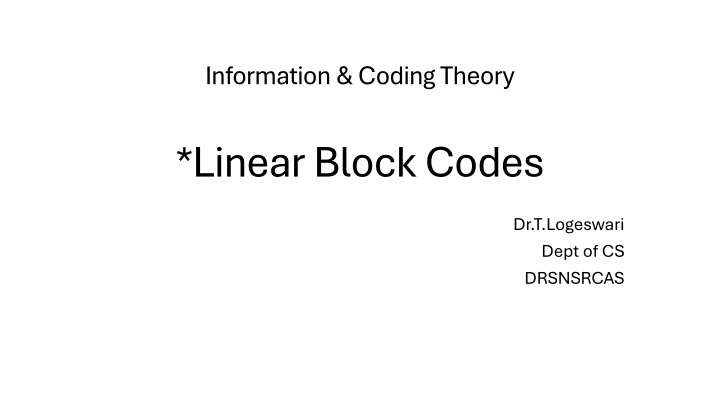
Linear Block Codes in Information and Coding Theory
Discover the fundamentals of linear block codes, a vital aspect of information and coding theory. Learn about their characteristics, generator matrix, parity-check matrix, and more in this comprehensive guide.
Download Presentation

Please find below an Image/Link to download the presentation.
The content on the website is provided AS IS for your information and personal use only. It may not be sold, licensed, or shared on other websites without obtaining consent from the author. If you encounter any issues during the download, it is possible that the publisher has removed the file from their server.
You are allowed to download the files provided on this website for personal or commercial use, subject to the condition that they are used lawfully. All files are the property of their respective owners.
The content on the website is provided AS IS for your information and personal use only. It may not be sold, licensed, or shared on other websites without obtaining consent from the author.
E N D
Presentation Transcript
Information & Coding Theory *Linear Block Codes Dr.T.Logeswari Dept of CS DRSNSRCAS
Linear Block codes Linear block codes are a class of error-correcting codes used in information theory and coding theory. These codes are defined by linear algebraic principles and exhibit specific mathematical properties that simplify their encoding and decoding processes. Here are the key characteristics and concepts related to linear block codes Linearity: Linear block codes are called "linear" because they satisfy the superposition property. This property states that the bitwise XOR (exclusive OR) operation of two valid codewords results in another valid codeword
Generator Matrix (G): A linear block code is often defined by a generator matrix (G). The generator matrix is used to generate codewords from the original information bits. The rows of the generator matrix are linearly independent, and each row corresponds to a codeword. The generator matrix has dimensions k n, where k is the number of information bits, and n is the block length.
Parity-Check Matrix (H) The parity-check matrix (H) is another matrix associated with a linear block code. It is used for error detection and correction. The parity-check matrix has dimensions (n k) n, where n is the block length and k is the number of information bits. The columns of H are linearly independent. In information theory and coding theory, a parity-check matrix is a crucial concept, particularly in the context of linear block codes. It is used for error detection and correction, providing a systematic way to check for errors in received codewords.
Systematic and Non-Systematic Parity-Check Matrices A systematic parity-check matrix has the property that it can be partitioned into an identity matrix (I) and a parity-check matrix (H p). Non-systematic parity-check matrices do not have this partitioning property, and they are often used in more general cases
